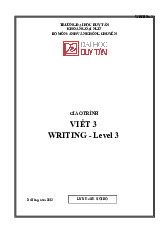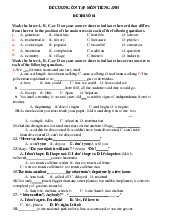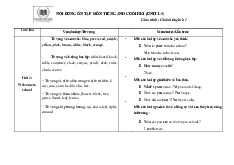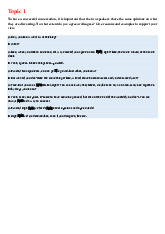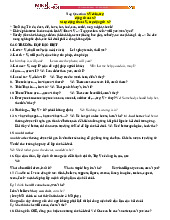











Preview text:
lOMoAR cPSD| 46836766
Unit 1: Raw material preparation
At the time of harvest or slaughter, most foods are likely contain contaminants, to have
components which are inedible or to have variable physical characteristics (for example shape,
size or colour ). It is therefore necessary to perform several unit operations of cleaning, sorting,
grading or peeling to ensure that foods with a uniformly high quality are prepared for
subsequent processing. These are mechanical separation procedures which are applied near the
beginning of a process to upgrade the quality of the raw material. They are highly costeffective
method of improving the overall quality of batches of foods. Cleaning
Cleaning is the unit operation in which contaminating materials are removed from foods
and separated to leave the surface of the food in a suitable condition for further processing.
Peeling fruits and vegetables, skinning meat or descaling fish may also be considered
as cleaning operations. In vegetable processing, blanching also helps to clean the product.
Cleaning should take place at the earliest opportunity in a food process both to prevent
damage to subsequent processing equipment by stones, bones or metals, and to prevent time
and money from being spent on processing contaminants which are then discarded. In addition,
the early removal of small quantities of foods contaminated by microorganisms prevents the
subsequent loss of the remaining bulk by microbial growth during the storage or delay prior to
processing. Cleaning is thus an effective method of reducing food wastage, improving the
economics of processing and protecting the consumers.
Cleaning is categorized into wet procedures (for example soaking, spraying and
flotation washing), and dry procedures (separation by air, magnetism or physical method).
The main groups of equipment used for wet cleaning are: spray washers, brush washer,
drum or piston washers and flotation tanks. And for dry cleaning are: air classifiers, magnetic
separators and separators based on screening foods.
I. Technical vocabulary and expressions slaughter (n) /'slɔ:tə/ killing of animals (esp. for sự giết mổ food) lOMoAR cPSD| 46836766 contaminant (n) /kən'tæminənt/ dirty, impure things chất bẩn, sự nhiễm bệnh inedible (adj) /ɪnˈedəbl/
( of a kind) not suitable to be không thể ăn được eaten grade (v) /greid/ arrange in order in grades or lựa, phân loại classes subsequent (adj) /'s Λ bsikwənt/ later, following tiếp theo sau mechanical (adj) /məˈkænɪkl/ connected with, produced by thuộc) ( cơ khí,cơ machines học procedure (n) /prəˈsiːdʒər/ the regular order of doing thủ tục, quy trình things variable (adj) /ˈveriəbl/ varying, changeable có thể thay đổi blanch (v) /b'la:n ʧ/ make or become pale or làm trắng white batch (n) /bæ ʧ/ number of (loaves, cakes, chuyến, mẻ foods, grains...) processed bá ( nh )... together categorize (v) /ˈkætəɡəraɪz/
place in a complete system or chia loại, phân loại group II. Grammar . The 1
Active Voice and The passive voice. The Active voice The Passive voice
Subject + verb + object Subject + verb (to be) +past participle (p2)
- They must remove contaminants from foods - Contaminants must be removed from contaminate (v) /kən'tæmineit/ make dirty, impure or làm bẩn, làm nhiễm diseased by touching or ( bệnh ) adding something impure
foods before processing before processing.
-Grinding reduces the size of solid foods. -The size of solid foods is reduced by grinding. 2 lOMoAR cPSD| 46836766
Note that The passive voice is used when it is not necessary to mention the doer of the action
(or when it is not so important who or what does/did the action) as we are more interested in what is/was done. Examples:
- A disc separator is used to separate grain from weed seeds.
- Concentrated dry effluent may be disposed of cheaply.
- Some mechanical separation procedures are applied near the beginning of a process to
upgrade the quality of the raw material.
2 . Defining Relative Clauses (introduced by which/ that ).
A clause is a part of a sentence. A relative clause tells us which person or thing (or what kind
of person or thing) the speaker means. A clause of this kind is essential to the clear
understanding of the noun preceding it. In the sentence:
-Dry-cleaning procedures are used for products which (that) are smaller, have greater
mechanical strength and posses a lower moisture content.
‘that (which) are smaller , have greater mechanical strength and posses a lower moisture
content’ is the relative clause. If we omit this, it is not clear what products we are talking about. Examples:
- At the time of harvest or slaughter, most foods are likely to contain contaminants, to
have components which (that) are inedible or to have variable characteristics.
- Cleaning prevents time and money from being spent on contaminants which (that) are then discarded.
- Mixing is a unit operation in which a uniform mixture is obtained from two or more
components by dispersing one within the other(s). (In this sentence you cannot use
that because there is a preposition preceding which.)
Note that sometimes we can omit which or that if it is the object of a verb:
- In oil-bearing seeds the oil which (that) we find inside cells are in small droplets.
Or: -In oil-bearing seeds the oil we find inside cells are in small droplets.
-Heat treatment is one of the most important methods which (that) we use in food processing.
Or: -Heat treatment is one of the most important methods we use in food processing. III. Reading tasks: lOMoAR cPSD| 46836766
Task 1: Match the word (line X) in the text with its appropriate definition.
1. sort (v) sth (out) –line 3
2. peel (v) –line 11
3. discard (v) –line 14
4. soak (v)sth in sth –line 19
5. remove (v) –line 8
6. improve (v) –line 17
7. delay (n) – line 16
8. prevent (v)sth/ sb from doing sth –line 12
9. reduce (v) –line 18
10. contaminate (v) –line 9
a. arrange in groups, separate things of one sort from things other sort
b. take the skin off (fruit, etc.)
c. throw out or away (sth useless, unwanted) d. make or become better
e. take off or away from the place/ something occupied
g. cause sth to absorb as much liquid as possible h. make dirty, or diseased f. time of being delayed i. stop or hinder
k. make less/ smaller in size, number or degree
Task 2: Fill in each blank with the right form of a suitable word in task 2
1. She is ................potatoes.
2. I must ...............my winter underclothing when the weather gets warm.
3. I usually ...............dirty clothes in water with soap before washing them.
4. The boy was ..................the stamps he had collected.
5. Flies.................food.
6. This is not good enough. I want to ...............it.
7. The rain ..................us from going on a picnic last week.
8. You are driving too fast. Can you ..................the speed?
9. We were late because of the ..................of the traffic.
10. What do you advise for................ink stains from clothes?
Task 3: Make one sentence from two using which/ that 4 lOMoAR cPSD| 46836766
1. Technical enzymes are added to foods as concentrated solutions or powder. They are
separated from microbial cells, or animal and plant sources. Technical
enzymes..................................................................................................................
2. Cleaning is an effective method. It reduces food wastage, improves the economics of
processing and protects consumers.
Cleaning is....................................................................................................................
3. Wet procedures produce large volumes of effluent. This requires to purchase clean water
and to pay for high effluent disposal charges. Wet
procedures..........................................................................................................................
4. In food fermentation, the production of foods can be achieved. The foods have new flavour and texture.
In food fermentation.................................................................................................
5. Wet cleaning is an effective method. It causes less damage than dry method.
Wet cleaning..........................................................................................................................
Task 4: Sentence transformation
Write a new sentence which has similar meaning to the first.
1 .They must remove contaminating materials from the foods before processing.
Contaminating………………………………………….....................................................
2. They usually use dry cleaning procedures for products that are smaller, have greater
mechanical strength and posses a lower moisture content.
Dry cleaning…......................................................................................................................
3. They use the method of food fermentation to produce foods that have new flavour or textures.
The method............................................................................................................................
4. They can achieve the desirable effects on eating quality by baking. The
desirable..............................................................................................................................
5. They use wet cleaning procedures to remove soil from root crops or dust and pesticide residues from soft fruits. Wet
cleaning.............................................................................................................................
Task 5: Complete the following sentences:
1.At the time of harvest or slaughter, most foods are likely……………………………….
........................................................................................... lOMoAR cPSD| 46836766
.......................................................
2. It is necessary to perform several unit operations of
…………………………………………
3. Wet cleaning and dry cleaning procedures are used
…………………………………………
4. Cleaning should take place at the earliest opportunity in food process to prevent …………..
………………………………………………………………………………………………….
5. Cleaning is an effective method of …………………………………………………………
………………………………………………………………………………………………….
Unit 2: Raw material preparation ( continued ) Wet cleaning
Wet cleaning is more effective than dry methods for removing soil from root crops or
dust and pesticide residues from soft fruits or vegetables. It is also dustless and causes less
damage to foods than dry methods. Different combinations of detergents and sterilants at
different temperatures allow flexibility in operation. However, the use of warm cleaning water
may accelerate chemical and microbial spoilage unless carefully control is exercised over 6 lOMoAR cPSD| 46836766
washing times and subsequent delays before processing. Furthermore, wet procedures produce
large volumes of effluent, often with concentrations of dissolved and suspended solids. There
is then a requirement both to purchase clean water and to pay for high effluent disposal charges.
To reduce costs, recirculated, filtered and chlorinated water is used whenever possible. Dry cleaning
Dry cleaning procedures are used for products that are smaller, have greater mechanical
strength and possess a lower moisture content ( for example grain and nuts). After cleaning,
the surfaces are dry, to aid preservation for further drying. Dry procedures generally involve
smaller cheaper equipment than wet procedures do and produce a concentrated dry effluent
which may be disposed of more cheaply. In addition, plant cleaning is simpler and chemical
and microbial deterioration of the food is reduced. However, additional capital expenditure
may be necessary to prevent the creation of dust that not only creates a health hazard but also recontaminates the product..
Classifiers use a moving stream of air to separate contaminants from foods. Classifiers
are widely used in harvesting machines to separate heavy contaminants (for example stones)
and light contaminants ( for example leaves, stalks and husks) from grain or vegetables.
Separation of contaminants from foods based on physical characteristics is possible
when the food has a regular well-defined shape. For example round foods (peas, blackcurrants
and rape-seed) are separated from contaminants by exploiting their ability to roll down an
inclined conveyor belt. Contaminants (for example weed seeds in rape seeds or snails in
blackcurrants) are carried up the conveyor and separated. A disc separator consists of a series
of vertical metal discs with precisely engineered indentations in the sides. It is used to separate
grain from weed seeds. The indentations match the shape of the grain and as the discs rotate,
the grain is lifted out and removed. Discs may be changed to separate barley, oats, rice or wheat.
Screens are also used to remove contaminants from foods.
I. Technical vocabulary and expressions
accelerate (v) /ək'seləreit/
increase the speed of, cause to move faster làm nhanh thêm, làm tăng nhanh aid (v) /eid/ help, serve giúp đỡ, lOMoAR cPSD| 46836766 cứu giúp deteriorate
make or become less value, or worse làm (v) hỏng, /di ' tiriəreit/ hỏng deterioration /diˌtiriə'reiʃn/ being deteriorated sự làm (n) hỏng hazard (n) /'hæzərd/ risk, danger mối nguy hiểm screen (v) /skri:n/ sàng separate (sth) into different sizes by passing through a screen so that sth will be removed vertical (adj) /'və:tikl/ a right angle of a line thẳng đứng
air classifiers /ɛə 'kla:sifaiə/ part used air bộ (n) phận kiểu khí động magnetic /mæg'netik/
machine based on magnetic force that is máy separator tách từ /'sepəreitə/ used to separate things tính 8 lOMoAR cPSD| 46836766 indent (v) /in'dent/
break into the edge on surface of (as if khưa with teeth) răng cưa indentation /ˌinden'teiʃn/ indenting or being indented sự (n) khứa răng cưa purchase (v) /'pə:ʧəs/ buy mua, tậu possess (v) /pə'zes/ own, have có, chiếm hữu conveyor /kən'veiə belt/ sth used to carry băng belt tải II. Grammar a- The past participle (P2)
+ Form: - The past participle of regular verbs is formed by adding ed or d to the infinitive, e.g.
worked, loved, watched.
-The past participle of irregular verbs: e.g. given, brought, written +Use: 1-As an adjective:
dissolved and suspended solids
recirculated, filtered and chlorinated water 2-To form the perfect tenses: Examples:
-We have separated contaminants from the nuts.
- Have you peeled all the potatoes?
3- After a noun or a pronoun to replace a relative pronoun + a passive verb: Examples:
-The main groups of equipment used (which are used) for dry cleaning are air
classifiers and separators based (which are based)on screening of foods.
-The early removal of small quantities of foods contaminated (that are contaminated)
by micro-organisms prevents the subsequent loss of the remaining bulk by microbial growth. b-The gerund lOMoAR cPSD| 46836766
+ Form: verb + ing e.g. cleaning, processing, blanching + Use: 1- The gerund as subject Examples:
-Peeling fruits and vegetables is also a cleaning operation.
-Packaging is an integral part of food processing.
- Cleaning should take place at the earliest opportunity in a food process. Sometimes you can say:
-Cleaning foods before processing is necessary.
Or: -It is necessary to clean foods before processing.
- Packaging foods is also very important.
Or: -It is important to pack foods. 2- Gerunds after prepositions Examples:
-It is necessary to perform several unit operations of cleaning, sorting, grading, or peeling.
- After cleaning, the surfaces of foods are dry.
-Wet cleaning is an effective method for removing soil from root crops or vegetables. 3- Verbs followed by gerund Examples:
- He practises scaling fish.
-We enjoyed baking meat over the camp fire.
- We like growing strawberries around our house. III. Reading tasks
Task 1: Match the word in (line X in the text) with its appropriate definition:
1. detergent (n) –line 3 a. remove sth from sth
2. suspend (v) –line 7 b. cut, gather, dig up (a crop)
3. dispose of (v) –line 15 c. (substance) that removes dirt, esp. from the surface of things
4. charge (n) –line 8 d. price asked for goods or services
5. circulate (v) –line 8 e. finish with, throw away because unwanted
6. preserve (v) –line 14
f. go around continuously, move from place to place freely
7. deteriorate (v) –line 17 g. risk, danger
8. hazard (n) –line 19 h. keep from decay, risk or going bad etc. 10 lOMoAR cPSD| 46836766
9. separate from(v) –line 35 i. make or become less value, or worse (in quality) 10.harvest (v) –line 27
k. (solid particles, in the air or other fluid medium) be or remain in place
Task 2: Fill in each blank with the right form of a suitable word in task 2:
1. There is a lot of ....................dust in the air.
2. People usually ................fruits by making them into jam.
3. Leather quickly ...................in hot, damp climate.
4. Smoking cigarettes causes people’s health ......................
5. We have to .................. the rubbish.
6. The hotel.................is very expensive.
7. In many buildings hot water.....................through pipes to keep the rooms warm.
8. We must .................the good from the bad.
9. They ................potatoes twice a year.
10. Most synthetic....................are in the form of powder or liquid. Task 3: True or False
1. Wet cleaning costs more money to dispose of the effluent than dry cleaning.
2. Wet cleaning causes more damage to foods than dry method.
3. Dry cleaning procedures involve smaller and cheaper equipment than wet procedures do.
4. Weed seeds can be separated from grain by a disc separator.
5. Recirculated, filtered and chlorinated water can be used for wet cleaning in order to reduce costs.
Task 4: Sentence transformation
Write the second so that it has the similar meaning to the first:
1. Producing foods which have new flavour and texture by fermentation method is simple.
It is...................................................................................................................................
2. It is easy to remove water from liquid foods by boiling.
Removing.........................................................................................................................
3. Separating contaminants from foods based on their physical characteristics is possible.
It is........................................................................................................................
4. Several types of cleaning procedures are required to remove the variety of contaminants found on most foods.
Several types of cleaning procedures are required to remove the variety of contaminants
which...................................................................................................................................... lOMoAR cPSD| 46836766
5. Foods produced by fermentation method have new flavours and textures that can’t be achieved by any others.
Foods which................................................................................................................
Task 5: Complete these following sentences
1. Wet cleaning is dustless and cause ……………………………………………………
2. The use of warm cleaning water may ………………………………………………….
3. Wet procedures produce………………………………………………………………...
4. The creation of dust after cleaning both ………………………………………………..
5. Foods may be recontaminated by
…………………………………………………………. 12
